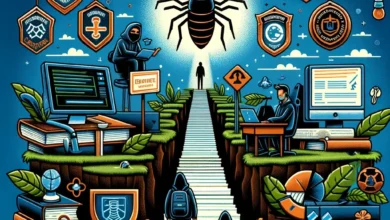Understanding Bug Bounty Scope and Rules: Navigating Program Guidelines
Mastering the Art of Understanding and Adhering to Bug Bounty Program Guidelines

In today’s rapidly evolving cybersecurity environment, bug bounty programs stand out as an innovative and collaborative approach to securing digital assets. These programs attract individuals with varying skill levels, from amateur enthusiasts to seasoned professionals, all with a shared goal: identifying vulnerabilities that might be overlooked during routine security audits. At the heart of every successful bug bounty hunt lies a profound understanding of the program’s scope and rules. In this extensive article, we unravel the intricacies of these guidelines, emphasizing their significance, offering strategies for their effective navigation, and presenting a roadmap to maximize bug-hunting achievements while staying within the defined parameters.
Unraveling the Mystique of Bug Bounty Program Boundaries
The bug bounty program scope is much more than a simple outline or a checklist for hunters to follow; it is the very essence and foundation upon which the entire endeavor is constructed. Imagine, for a moment, an artist approaching a blank canvas. The canvas itself, its size, texture, and constraints define the space within which the artist must work. Similarly, the scope is the ‘canvas’ for bug hunters, setting the stage for where their expertise can shine and where it must be restrained.
As hunters embark on their digital expedition, the scope provides them with clarity and direction. It tells them where to tread lightly, where they can delve deep, and where they must not venture at all. It is a clear reflection of an organization’s priority areas, drawing attention to systems or assets deemed most critical or perhaps most vulnerable. At the same time, by marking certain areas as off-limits, the scope ensures that business-critical, sensitive, or out-of-bounds systems remain undisturbed, thereby preserving the organization’s integrity and operations.
While it’s tempting for enthusiastic hunters to test every nook and cranny of a system, the defined scope ensures that their efforts are channeled appropriately. The value of this focused approach cannot be overstated. It leads to more relevant findings, ensures that critical systems are not inadvertently compromised, and sets the stage for a more streamlined and effective vulnerability reporting process.
Beyond the practicalities, understanding the scope also gives insights into an organization’s cybersecurity mindset. It reveals what they consider valuable, what they deem at risk, and how open they are to external scrutiny. For the discerning hunter, these insights can be as valuable as technical details, guiding their approach and strategy.
In the end, the scope is not just a boundary; it’s a beacon guiding bug hunters toward a successful and rewarding exploration while ensuring the overarching goals of the program are met.
The Imperative of Crystal-Clear Rules in the Bug Bounty Landscape
The digital arena of bug bounty hunting is akin to a vast wilderness filled with myriad paths, unexpected challenges, and immense potential. While the scope of a bug bounty program provides the map for this terrain, it is the rules that set the ground principles for the journey. Rules are not mere guidelines; they are the pillars that uphold the integrity, purpose, and mutual respect within the bug bounty ecosystem.
Rules are essential for multiple reasons:
- Ensuring Fair Play: Just as sports have rules to ensure every participant has an equal opportunity and plays fairly, bug bounty programs require rules to create a level playing field. For instance, if a program prohibits automated scanning, this ensures that all participants rely on manual techniques, preventing any single participant from flooding the system and potentially gaining an unfair advantage.
- Protecting Both Parties: Rules safeguard both the organization and the bug hunter. For the organization, rules can prevent unwanted disruptions. Consider an e-commerce site which, without clear rules, could be bombarded with traffic or malicious payloads, disrupting its operations. For hunters, these rules ensure they aren’t inadvertently crossing legal boundaries. For example, a well-defined rule might state that hunters shouldn’t access other users’ personal data, thereby preventing potential privacy violations.
- Streamlining Communication: Rules often dictate the format and channels of communication. For a hunter, knowing exactly how to report a vulnerability, in what detail, and through which medium can expedite the process. An organization might specify, for example, that all reports should include a proof of concept, steps for reproduction, and potential impact, ensuring that they receive consistent, actionable information.
- Determining Reward Parameters: Without clear rules, there can be ambiguity about rewards. Rules can delineate criteria like the severity of bugs, their uniqueness, or the quality of the report, all of which can influence bounties. For instance, a rule might state that only the first report of a unique vulnerability qualifies for a reward, ensuring hunters understand the importance of speed and originality.
- Upholding Ethical Standards: The world of cybersecurity is replete with ethical considerations. Rules can define what’s acceptable and what’s not, thereby setting the moral compass for hunters. An organization might explicitly rule out attempts to exfiltrate data, launch denial of service attacks, or exploit vulnerabilities in a malicious manner, ensuring hunters maintain the high ground.
While the allure of bug bounty hunting lies in the thrill of the chase and the potential rewards, it’s the rules that provide the structure and ethos for this pursuit. They ensure that the journey is beneficial, respectful, and, above all, conducted with the highest standards of integrity and professionalism.
Mastering the Terrain: Navigating and Decoding Bug Bounty Program Guidelines
Bug bounty programs represent a digital frontier teeming with potential for discovery. They beckon bug hunters with their challenges and promise of rewards. However, the true secret to success in this domain isn’t just about technical prowess but a meticulous understanding of the program’s guidelines. Before embarking on this cybersecurity adventure, it’s vital to master the art of navigating and interpreting these rules.
The allure of bug bounty programs often lies in the challenges they present. Yet, one must not dive headfirst without a preliminary reconnaissance of the program’s guidelines. Here’s a strategic approach:
- Starting with the Basics: At the outset, grasp the basic tenets of the program. What is the primary objective of the program? Is it a public program welcoming all, or is it private, extended to a select group of hunters? For instance, some high-profile companies run invitation-only programs where only reputed hunters are involved. Knowing this can set the tone for your entire hunting process.
- Scope Decoding: Delve deep into the specifics of the program’s scope. Does it encompass only certain domains or specific IP ranges? Are there any applications or systems that are strictly off-limits? For instance, a company might have an online payment portal as part of its vast digital infrastructure but has kept it out of the program’s scope due to potential financial implications. Testing outside of this scope could not only disqualify you but may also have legal ramifications.
- Engage with Provided Resources: Some programs offer auxiliary resources like documentation, FAQs, or forums. A company might provide an extensive knowledge base detailing known issues they’ve already addressed. This can help you avoid submitting duplicates and focus your energy on uncharted territories.
- Rules and Engagement Clarity: Understand the dos and don’ts. While it’s tempting to unleash every tool in one’s arsenal, some programs might have restrictions on aggressive scans or specific tools. For example, an organization might disallow any form of Denial-of-Service attacks to ensure uninterrupted services to its users.
- Vulnerability Classification: Delve into how the program classifies vulnerabilities. Are there specific categories they’re particularly interested in, or perhaps ones they consider out-of-scope? A platform may prioritize vulnerabilities leading to data breaches but consider UI glitches as non-critical.
- Seek Clarification: When in doubt, ask! Instead of making assumptions, use official channels to seek clarifications. For instance, if you’re unsure whether testing a subdomain is allowed, a quick query to the program’s point of contact can provide clarity.
- Feedback and Iterative Learning: Once you begin submitting reports, pay attention to the feedback. This isn’t just about acceptance or rejection but understanding the program’s perspective. Maybe you missed an aspect of the guidelines, or perhaps they provide insights on how to make your next report even better.
In essence, successful bug hunting within a program isn’t solely about finding vulnerabilities. It’s an intricate dance of understanding, adhering to, and leveraging program guidelines to one’s advantage. The guidelines, when navigated strategically, can illuminate the path to becoming a distinguished and respected bug hunter in the community.
Elevating Your Game: Harnessing Guidelines to Supercharge Your Bug-Hunting Endeavors
The vibrant world of bug bounties operates at the nexus of challenge and compliance. While guidelines may appear restrictive at first glance, they aren’t shackles. They’re guideposts, helping hunters tread the right path without crossing boundaries. The true mark of an adept bug hunter is not just in discovering vulnerabilities but in doing so within the framework set by the guidelines, turning perceived constraints into avenues of opportunity. Here’s how you can thrive:
- Recognizing Boundaries as Opportunities: It’s easy to look at a restrictive scope and feel confined. However, limitations can often lead to innovation. For instance, if a particular program rules out certain common attack vectors, it pushes you to think out of the box, possibly leading you to find less obvious yet critical vulnerabilities. An API might be off-limits, but the associated mobile app might not be, presenting a different yet connected attack surface.
- Prioritize and Strategize: If the guidelines lay special emphasis on certain types of vulnerabilities or particular systems, prioritize them. For instance, a program might offer higher rewards for vulnerabilities found in their primary web application as compared to their auxiliary platforms. By aligning your hunting priorities with the program’s, you ensure a higher chance of impactful discoveries.
- Building Bridges with Program Managers: Establish a line of communication with program managers or the platform’s support team. Keeping channels open not only assists in clarifying doubts but also creates a positive rapport. For example, after a series of submissions, you might receive feedback on how a particular report was very well-documented. This feedback can act as a guide for your subsequent submissions, ensuring a higher acceptance rate.
- Exploiting Real-world Scenarios: Guidelines often appreciate vulnerabilities that come with real-world exploitation scenarios. Instead of just presenting a theoretical flaw, demonstrate its impact. If you uncover a potential data leak, exemplify how a malicious actor might harness it to gain unauthorized access.
- Refinement through Peer Learning: Engage with fellow bug hunters, especially if they’ve had success with the same programs. Platforms often host forums or discussion boards. By understanding others’ approaches (within the ethical boundaries, of course), you can refine your own. Perhaps a fellow hunter used a unique tool or technique that aligns perfectly with the program’s guidelines, opening new avenues for exploration.
- Continuous Evolution: The realm of cybersecurity is dynamic, with new vulnerabilities and techniques emerging regularly. Use guidelines as a base, but continuously update your skills. For instance, a program might introduce new systems or technologies. Familiarizing yourself with the latest in those areas can give you an edge.
By viewing program guidelines as well-trodden paths rather than barriers, you position yourself for greater success. The guidelines don’t exist to impede but to steer, ensuring both the bug hunter and the organization benefit. When approached with the right mindset, these guideposts can become your greatest allies, amplifying your bug-hunting potential manifold.
In Conclusion: Sculpting the Future of Ethical Hacking Through Informed Hunting
The realm of bug bounties and ethical hacking has undergone a transformative journey, evolving from a niche curiosity to a vital aspect of organizational cybersecurity. As organizations open up their digital ecosystems to scrutiny by ethical hackers, there emerges a dynamic interplay of trust, skill, and knowledge. However, this symbiotic relationship is held together by the thread of well-defined guidelines that ensure alignment between the hunter’s objectives and the organization’s security goals.
This intricate dance of challenge and compliance encapsulates the essence of modern ethical hacking. Successful bug hunting is not merely about leveraging technical acumen to uncover vulnerabilities. It also revolves around the ability to operate within predefined boundaries, demonstrating a profound respect for the program’s guidelines. The stringent adherence to these guidelines not only protects the interests of organizations but also elevates the standing of the ethical hacking community. By fostering an image of professionalism and responsibility, informed hunting reinforces the importance of ethical hackers in today’s cybersecurity landscape.
In the grand tapestry of cybersecurity, ethical hacking stands out as a proactive approach to defense. It flips the conventional narrative, turning potential adversaries into allies. As bug bounty programs proliferate, understanding and adhering to their guidelines become paramount. Only by marrying technical prowess with an unwavering commitment to these guidelines can ethical hackers truly sculpt the future of this domain, ensuring a safer digital world for all.
The horizon beckons with promises of discoveries, challenges, and triumphs. However, for every bug hunter charting this territory, the compass of program guidelines remains an indispensable tool. It’s through informed and responsible hunting that the future of ethical hacking will be molded, steering the course toward a robust and resilient digital ecosystem.




